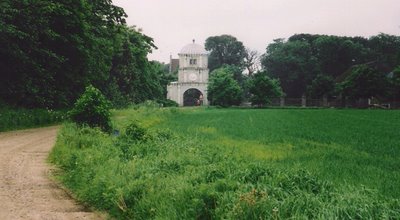
Stjær kirke, ab 15 km west of Aarhus
Stjær sogn, Framlev herred, Aarhus amt.

In the parish is a very hilly terrain from northeast. Tåstrup sø, only 12 m above sea level, lies to the southwest where the surface in several places are above 100 m and the highest point 129 m, north of Vindskovgård. In the parish is a listed forest, Stjær Stenskov, with an interesting stone-sprinkling , a rest from the melt-down in Ice Age.
The church lies in the middle of Stjær village. It was built in the 1100s and has a Romanesque nave and choir and a later added tower to the west and a porch to the south. Nave and choir are in granite ashlars, and the white-washed tower from the end of the Middle Ages is in ashlars, granite boulders and monk bricks, while the porch from recent time is in yellow bricks. The finest ornament in Stjær church is the magnificent south door with its pillars with reliefs of Samson and Michael(?), while the cover stone between two winged lions has a tympanum field with a crucifixion group. In the choir is built a cross vault, the nave has a beamed ceiling. The choir arch is extended, ashlars from the old choir arch are at the church yard. The tower has round arch openings with a middle pillar at all sides. A highplaced door at the northside is out of use after the vault of the tower was broken down.

(click to enlarge)
Communion table in oak from the same time as the neo Romanesque altarpiece with a painting from 1896. New candelabres. A Romanesque granite font with lions, birds and akanthus-decoration. A small baptismal bowl, Netherland type from ab. 1650. Pulpit in neo Romanesque style; the earlier pulpit was from 1601. The pews are from the end of the 1800s. To the west a gallery with organ. The bell is cast in 1876. Below the gallery hangs a memorial tablet for Dannebrogsmand ( medal) J.M.A. Juul and farmer Mads Jensen, who each gave 100 rigsbankdaler to the church.


Animal reliefs the portal
New decoration in 2006.
Inside Stjær church was in 2006 decorated by Stjær Billedmagere (picture artists). They created it with a respect for the church and the inventory . The colours are green and red nuances with a white cross upon benches, in windows and upon the chausuble. The white cross = The Holy Spirit Cross.
Names in the Middle Ages:
Stjær: (*1326 Styærdhæ; 1480 Stiær).
When ploughing a field in Stjær was in 1803 found a big number of copper coins ( ca. 9500 pieces) from Erik Menveds period, put down ab. 1319.
Prehistoric:
There are no listed preshistorics in the parish but there were 25 hills, which now all are demolished . In a hill north of Stjær was a rich grave from Roman Iron Age with a bronze dish , a wooden bucket, glass bowl, a bone comb, silver ring etc. Not far from here was found two gold bars from Iron Age.
Sources: Trap Danmark, Århus amt, 1963; Stjær sogneside

photo Stjær kirke 2002: grethe bachmann







